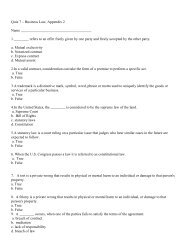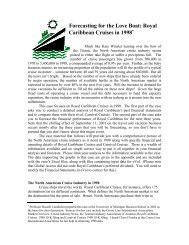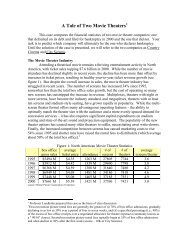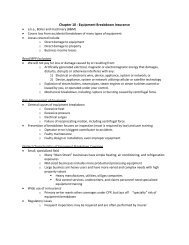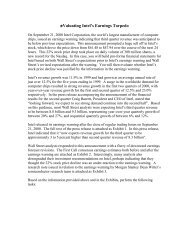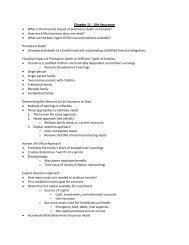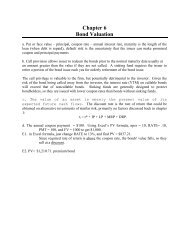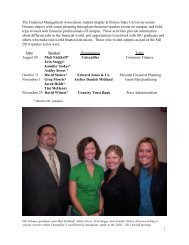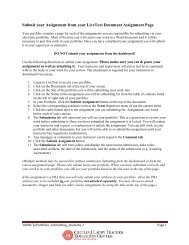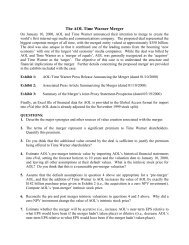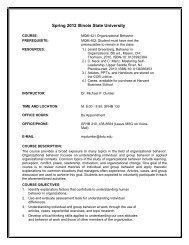Evaluating a Firm's External Environment - Illinois State University
Evaluating a Firm's External Environment - Illinois State University
Evaluating a Firm's External Environment - Illinois State University
You also want an ePaper? Increase the reach of your titles
YUMPU automatically turns print PDFs into web optimized ePapers that Google loves.
M02_BARN4586_03_SE_C02.qxd 7/1/09 7:34 AM Page 39<br />
Chapter 2: <strong>Evaluating</strong> a Firm’s <strong>External</strong> <strong>Environment</strong> 39<br />
the line in Figure 2.4. This curve suggests that any deviation, positive or negative,<br />
from an optimal level of production (point X in Figure 2.4) will lead a firm to experience<br />
much higher costs of production.<br />
To see how economies of scale can act as a barrier to entry, consider the following<br />
scenario. Imagine an industry with the following attributes: The industry has five<br />
incumbent firms (each firm has only one plant); the optimal level of production in<br />
each of these plants is 4,000 units (X = 4,000 units); total demand for the output of this<br />
industry is fixed at 22,000 units; the economies-of-scale curve is as depicted in Figure<br />
2.4; and products in this industry are very homogeneous. Total demand in this industry<br />
(22,000 units) is greater than total supply (5 4,000 units = 20,000). Everyone<br />
knows that, when demand is greater than supply, prices go up. This means that the<br />
five incumbent firms in this industry will have high levels of profit. The S-C-P model<br />
suggests that, absent barriers, these superior profits should motivate entry.<br />
However, look at the entry decision from the point of view of potential<br />
entrants. Certainly, incumbent firms are earning superior profits, but potential<br />
entrants face an unsavory choice. On the one hand, new entrants could enter the<br />
industry with an optimally efficient plant and produce 4,000 units. However, this<br />
form of entry will lead industry supply to rise to 24,000 units (20,000 + 4,000).<br />
Suddenly, supply will be greater than demand (24,000 > 22,000), and all the firms in<br />
the industry, including the new entrant, will earn negative profits. On the other<br />
hand, the new entrant might enter the industry with a plant of smaller-than-optimal<br />
size (e.g., 1,000 units). This kind of entry leaves total industry demand larger than<br />
industry supply (22,000 > 21,000). However, the new entrant faces a serious cost disadvantage<br />
in this case because it does not produce at the low-cost position on the<br />
economies-of-scale curve. Faced with these bleak alternatives, the potential entrant<br />
simply does not enter even though incumbent firms are earning positive profits.<br />
Of course, potential entrants have other options besides entering at the efficient<br />
scale and losing money or entering at an inefficient scale and losing money.<br />
For example, potential entrants can attempt to expand the total size of the market<br />
(i.e., increase total demand from 22,000 to 24,000 units or more) and enter at the<br />
optimal size. Potential entrants can also attempt to develop new production technology,<br />
shift the economies-of-scale curve to the left (thereby reducing the optimal<br />
plant size), and enter. Or, potential entrants may try to make their products seem<br />
very special to their customers, enabling them to charge higher prices to offset<br />
higher production costs associated with a smaller-than-optimal plant. 15<br />
Any of these actions may enable a firm to enter an industry. However, these<br />
actions are costly. If the cost of engaging in these “barrier-busting” activities is<br />
greater than the return from entry, entry will not occur, even if incumbent firms<br />
are earning positive profits.<br />
Historically, economies of scale acted as a barrier to entry into the worldwide<br />
steel market. To fully exploit economies of scale, traditional steel plants had to be<br />
very large. If new entrants into the steel market had built these efficient and large<br />
steel-manufacturing plants, they would have had the effect of increasing the steel<br />
supply over the demand for steel, and the outcome would have been reduced<br />
profits for both new entrants and incumbent firms. This discouraged new entry.<br />
However, in the 1970s, the development of alternative mini-mill technology<br />
shifted the economies-of-scale curve to the left by making smaller plants very efficient<br />
in addressing some segments of the steel market. This shift had the effect of<br />
decreasing barriers to entry into the steel industry. Recent entrants, including<br />
Nucor Steel and Chaparral Steel, now have significant cost advantages over firms<br />
still using outdated, less efficient production technology. 16



